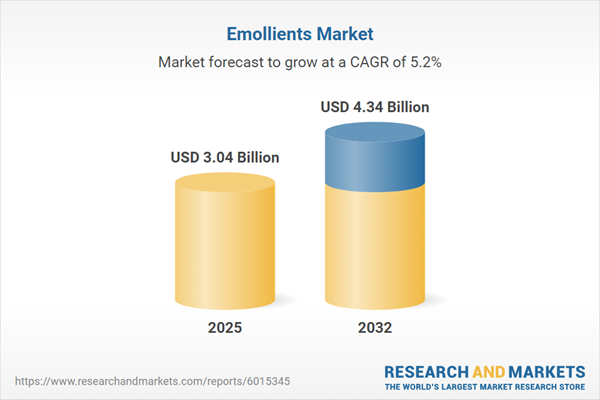Speak directly to the analyst to clarify any post sales queries you may have.
The emollients market navigates constant change as regulatory updates, evolving consumer expectations, and technological progress drive both disruption and opportunity. For senior leaders, timely adaptation is essential to maintain resilience and capture value in this competitive space.
Market Snapshot: Growth and Outlook in the Emollients Market
The emollients market is posting steady year-over-year growth, underpinned by ongoing demand across personal care, dermatology, and pharmaceutical sectors. Advancements in ingredient formulation and a sharper focus on meeting user needs are fueling new product development. Established market players and new entrants alike are expanding adoption, solidifying emollients' integral role in global skincare and therapeutic solutions. As formulations improve, businesses are leveraging the versatility of emollients to deliver across regional and industry lines—demonstrating their essential presence in healthcare and beauty routines worldwide.
Scope & Segmentation: In-Depth Emollients Market Insights
This report offers senior executives a segmented perspective to inform leadership decisions about sourcing, innovation, and positioning within the emollients market.
- Product Types: Humectants (like glycerin, lactic acid, urea), lubricants (alcohols, esters, fatty acids), natural oils and butters (almond, coconut, jojoba, shea), and occlusive agents (dimethicone, lanolin, mineral oil, petrolatum) each target specific formulation and end-user requirements.
- Forms: Liquid, semi-solid, and solid formats enable businesses to tailor innovative applications across various finished product categories and market needs.
- Sources: Natural, semi-synthetic, and synthetic options reflect shifting sustainability targets, helping manufacturers meet compliance and traceability demands.
- End Users: Dermatologists, cosmetics manufacturers, personal care brands, and pharmaceutical firms tap emollients for both existing and future-oriented product lines.
- Distribution Channels: Offline retail and e-commerce avenues are propelling brand visibility and supporting agile supply chains, especially in growth markets.
- Geographic Regions: The Americas, Europe/Middle East/Africa, and Asia-Pacific are examined in depth, with country-level data for precise go-to-market planning.
- Leading Companies: Notable players such as Ashland Inc., BASF SE, Croda International Plc, Dow Inc., and Johnson & Johnson Services, Inc. exemplify competitive moves and investment trajectories.
- Emerging Technologies: Encapsulation and microemulsion systems are being adopted to boost both product safety and functional stability.
- Regulatory and Digital Influences: Evolving regulatory requirements and increased use of digital technologies are changing both consumer engagement models and operational efficiency across the industry.
Key Takeaways for Senior Decision-Makers
- Clean-label and plant-based emollients are steadily setting new standards for ingredient transparency and supporting supply chain traceability across regions.
- The adoption of advanced delivery mechanisms, including encapsulation, improves safety and stability attributes that appeal to procurement specialists and quality assurance teams.
- Growing digitalization enables real-time monitoring for procurement and portfolio managers, driving more responsive product launches and faster time to market.
- Stronger collaboration between suppliers and contract manufacturers is enhancing compliance capabilities, adding technical flexibility, and shortening new product development cycles.
- Enhanced use of analytics in procurement and inventory management boosts organizational agility, helping businesses quickly align with shifts in demand.
Tariff Impact: Navigating Trade Complexities in the Emollients Market
Recent United States tariffs are leading emollient manufacturers to reassess sourcing and procurement strategies, resulting in a move toward near-shoring. These policy-driven changes are influencing supplier relationships and pricing structures, requiring greater adaptability as trade dynamics evolve.
Methodology & Data Sources for Reliable Emollients Sector Insights
This analysis draws on interviews with formulation scientists, procurement leaders, and dermatologists. Supplementary desk research includes current scientific literature, updated regulatory guidelines, and insights from industry associations to ensure the reliability and depth of findings.
Why This Report Matters for B2B Emollients Market Stakeholders
- Delivers actionable insights to support innovation, accelerate time to market, and reinforce supply chain resilience in the emollients market.
- Equips senior teams with a clear understanding of technology, digital advancement, and regulatory shifts to enable agile decisions.
- Prepares organizations to adapt rapidly to market fluctuations and preserve strategic differentiation as conditions shift.
Conclusion: Charting a Strategic Path in the Emollients Industry
This report empowers senior decision-makers with the clarity and guidance to strengthen organizational strategies in the evolving emollients sector. Leveraging these insights supports sustained growth amid changing global requirements.
Additional Product Information:
- Purchase of this report includes 1 year online access with quarterly updates.
- This report can be updated on request. Please contact our Customer Experience team using the Ask a Question widget on our website.
Table of Contents
3. Executive Summary
4. Market Overview
7. Cumulative Impact of Artificial Intelligence 2025
Companies Mentioned
The companies profiled in this Emollients market report include:- Ashland Inc.
- BASF SE
- Berg + Schmidt GmbH & Co. KG
- Cargill Incorporated
- Clariant AG
- Covestro AG
- Croda International PLC
- Dow Inc.
- Eastman Chemical Company
- Evonik Industries AG
- Gattefossé SAS
- Hallstar Innovations Corp.
- Innospec Inc.
- Johnson & Johnson Services, Inc
- Kao Corporation
- Lonza Group AG
- Oleon NV
- Solvay SA
- Sonneborn LLC
- Stepan Company
- The Lubrizol Corporation
- The Procter & Gamble Company
- Vantage Specialty Chemicals, Inc.
Table Information
| Report Attribute | Details |
|---|---|
| No. of Pages | 188 |
| Published | November 2025 |
| Forecast Period | 2025 - 2032 |
| Estimated Market Value ( USD | $ 3.04 Billion |
| Forecasted Market Value ( USD | $ 4.34 Billion |
| Compound Annual Growth Rate | 5.1% |
| Regions Covered | Global |
| No. of Companies Mentioned | 24 |









